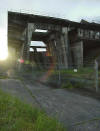
The 9000-acre site now occupied by the Range used to be known as the Spadeadam Wastes, mostly remote and uninhabited, until 1957 when the Intermediate Range Ballistic Missile Test Centre was built. This was called the Blue Streak Project and was made up of a consortium of companies including De-Havilland, Rolls Royce and British Oxygen.
RAF Spadeadam is the only Electronic Warfare Tactics Range (EWTR) in the UK, and the only one of two such facilities in Europe. The other facility being Polygon, in Germany.
The Range provides realistic Electronic Warfare training for aircrew, primarily for the RAF, but other NATO Air Forces use the range as well. The task sounds straightforward but in practice is difficult to achieve and extremely expensive. The task is achieved by fielding a variety of equipments that emit signals that appear to aircrews as threat radars. The threat systems consist of Short Range Air Defence (SHORAD) systems, Surface to Air Missile systems (SAM) and Anti-Aircraft Artillery (AAA) radars. Additionally, they have an array of visual targets including a dummy airfield, complete with aircraft, missile sites and vehicle convoys. The aircrews try to evade the threats, whilst carrying out their assigned mission. The aim is to achieve realistic Electronic Warfare training.
The following few photographs, were taken during a Subterranea Britannica Visit to the facility on 3rd July 2002.
Spadeadam was opened in the late 1950s as a test area for the British Intermediate Range Ballistic Missile (IRBM).
The research program was split between Rolls Royce and Dehavilland (later Hawker Siddley). Dehavilland were responsible for the airframe and Rolls Royce for the RZ 2 rocket engines.The first rocket firing took place in August 1959, but by this time the Fixed Site Ballistic Missile (FSBM) was being phased out. The British program was cancelled in 1958 after the deployment of American THOR missile sites in eastern England.